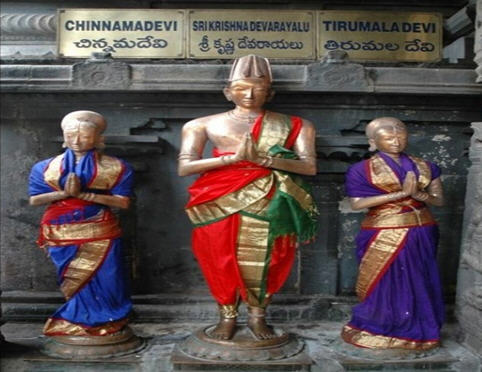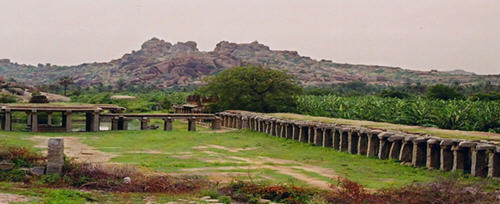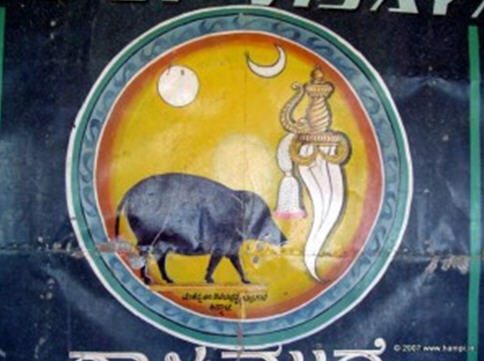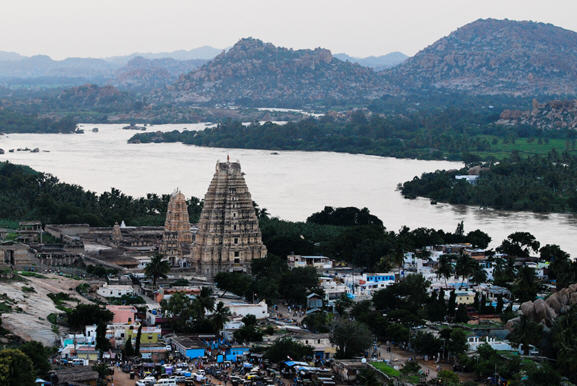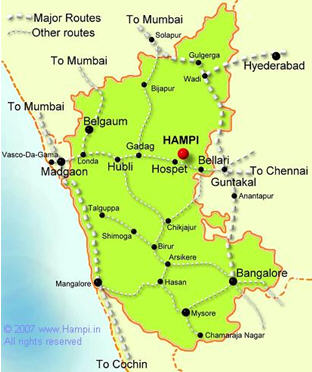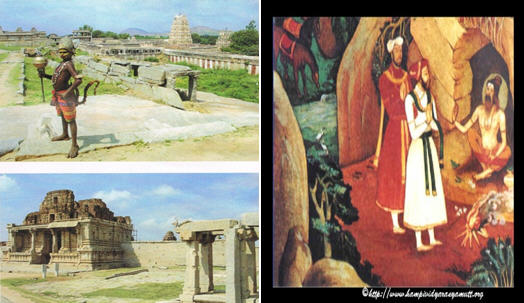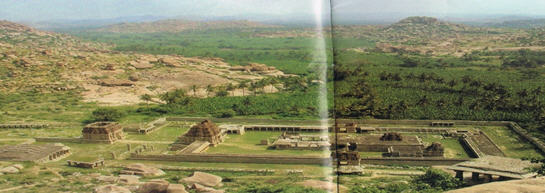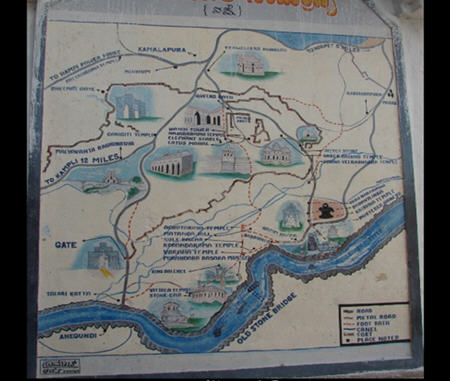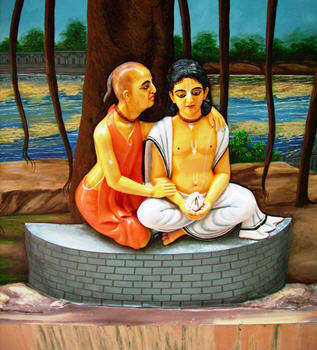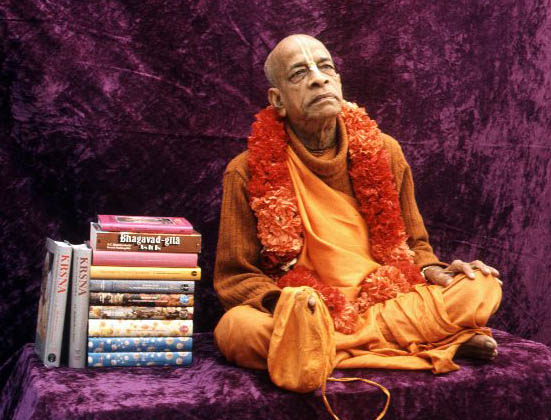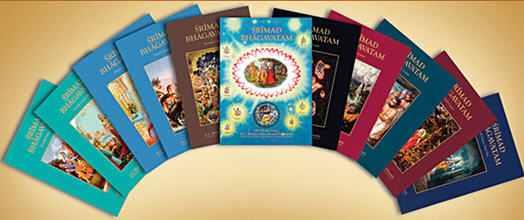Hampi has various notable Hindu temples, some of which are still active places of worship. Among the most notable are:
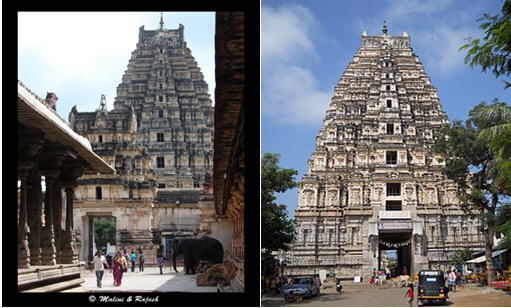
Virupaksha Temple
Virupaksha Temple: Known as the Pampapathi temple, it is a Shiva temple situated in the Hampi Bazaar. It predates the founding of the Vijayanagar Empire. The temple has a 160-foot (49 m) high tower at its entrance. Apart from Shiva, the temple complex also contains shrines of the Hindu goddesses Bhuvaneshwari and Pampa.
The Virupaksha temple, located at the foot of the hill called Hemakuta Hill, is the core of the village of Hampi. The temple, often called Pampapathi temple, is the most sacred of the temples of this place.
Historically speaking, this temple has an uninterrupted history from about the 7th century. The temple contains the shirines of Lord Shiva, Pampa and Bhuvaneshwari. It was once a small shrine, in course of time, developed into a large complex under the Vijayanagara rulers. At present, the main temple consists of a sanctum, three ante chambers, a pillared hall and a Mukhamantapa also called Rangamantapa or an open pillared hall. A pillared cloister, entrance gateways, courtyards, attendant shrines and other manttapas surround the temple. In 1510 A.D. Krishnadevaraya added the above-mentioned Rangamantapa.
The Rangamantapa consists of 38 pillars, relieved with sculptures. These pillars are divided into two vertical sections – the first is cut to resemble a rearing Yali – a mythical lion, standing on a Makara, while the second section is basically square with small relief, depicting mostly Shaiva themes. These pillars are aesthetically composed and skilfully constructed.
The central ceiling of the Rangamantapa is of substantial size. The ceiling as well as the beams supporting the ceilings is covered with painted panels. The panel depicts themes from the Mahabharatha, the Ramayana and the Shiva Puranas as well as from the contemporary life.
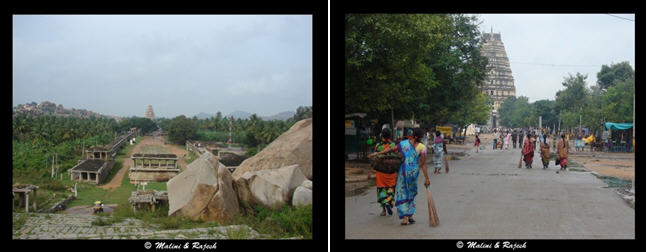
Virupaksha Bazaar
Starting at the entrance of the temple is Virupaksha Bazaar or market, largest of the many bazaars of Vijayanagara. Each major Temple complex had its own bazaar around which a township developed. This is the only bazaar around which a township of a sort still exists. This bazaar is flanked by the main gopura of Virupaksha temple called Bishtappa’s gopura on the one end and the monolithic Nandi at the other end. The 9 storied, 53 meters high gopura adds elegance to the 732 meters long and 28 meters wide Virupaksha Bazaar.
The other temple of significance in this complex is the shrine for Goddess Bhuvaneshwari. This shrine was rebuilt in the Vijayanagara days, over an 11th century temple. This temple is chiefly noted for its marvelously worked door-frame, pillars and articulately chiselled ceiling panels.
In the basement of the temple is a shrine with a deity of Lord Vishnu holding scale, said to be for weighing the merits between the holy places of Kashi and Pampa Kshetra, which wins out.
Balakrishna Temple

Balakrishna Temple
Krishnadevaraya built this temple in 1513 A.D. to commemorate his victory over Prataparudra Gajapati, the ruler of Orissa. During the battle he seized deity of child Krishna and brought it to Vijayanagara as war trophy. He then built this temple to consecrate the deity. An inscription describing the conquest and the consecration of this temple on 16 February 1515 by Krishnadevaraya is found on a slab in front of this temple. Built in the centre of a courtyard, the temple possesses a sanctum, an antechamber, an ardhamandapa, a circumambulatory passage, a pillared hall with three entrances and an open pillared mandapa, in addition to a number of other shrines for the attendant deities. The sanctum is at present empty. The image of Balakrishna showing him as a child holding butter in the right hand is now resting in the Government Museum at Madras.
The inner sides of the entrance exhibit beautifully sculptured apsaras standing on mysterious animals and holding scrolls filled with panels showing the ten incarnations of the Lord. Like all major temple complexes, Krishnapura, a suburb, is developed around this temple. The bazaar in front is now a lush paddy field.
Shri Vijaya Vitthala Temple

Shri Vijaya Vitthala Temple
If one wants to witness the competition between man and Vishwakarma (the Architect God of Hindus), this is the place on earth. Any number of words would fail to do justice to this wonderful monument dedicated to Lord Vitthala or Lord Vishnu. Legend has it that Lord Vishnu found it too grand to live in and thus returned to his own humble home. The Stone Chariot is situated to the east of the temple hall. By far, this is the most amazing monument in Hampi and is portrayed as the icon for Hampi.
History- The construction of this temple started during the reign of King Krishna Deva Raya in the year 1513 AD. The project was so colossal that the additions continued for almost five decades until the Empire fell down in the year 1565 AD and was never completed.
Architecture: Built mainly on the original Dravidian temple architecture, this temple has all those which a typical south Indian temple would have. There is a small main inner sanctum where the deities are placed. Only the chief priest of the temple is permitted inside this sanctum. The smaller sanctum is followed by a bigger outer shrine where the general public is allowed. The monumental decoration of the temple can be seen mainly in this bigger outer house.
The temple stands, within high walls with 3 gateways on the east, south and north. The temple stands on a strong stone basement with richly carved designs of the King’s army and dancing girls. The dancing halls and kalyanamandapas in the corners are equally worth noticing.
The carvings on this temple give an insight into the architectural splendor achieved by the artisans of Vijayanagara Empire. The temple consists of 56 musical pillars. When tapped gently, these pillars produce musical sounds. These pillars are popularly known as Musical Pillars or SaReGaMa pillars after the sapthaswaras of the Indian classical music. The British wanted to check the reason behind this wonder and so they had cut two pillars to check anything was there inside the pillars that were producing the sound. They had found nothing but hollow pillars. Even today we can see those pillars cut by the British.
To the east of the hall is the famous Stone Chariot with stone wheels that actually revolve. In front of the shrine stands the great mandapa.
The road leading to the temple was once a market where the horses were traded. Even today we can see the ruins of the market on both the sides of the road. The temple contains the images of foreigners like Persians selling horses.
Hazari Rama Temple
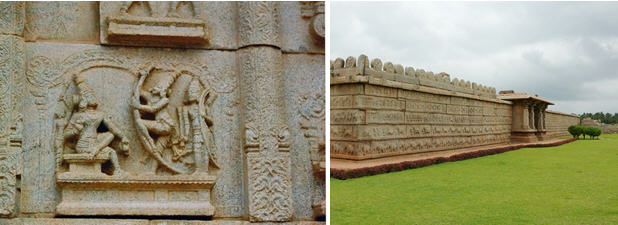
This temple for Lord Rama is popularly called “Hazari Rama Temple” or “Hazara Rama Temple” because of the large number of Ramayana panels on the walls. This temple is believed to have been the private place of worship of the Royal family. It was originally called Hajana Rama, which in Telugu means “the palace temple.”
Originally, the temple consisted of a sanctum, an ardhamandapa and a pillared hall to which an open porch with tall and elegant pillars was added subsequently. A high wall encloses the entire complex with the main entrances set on the east. To the south is a small doorway, which leads to the Durbar Area. The pillar hall is notable for its unique pillars in black-stone. They are set on a raised stone platform in the middle of the hall.The tall and elegant pillars of the open porch also worth a second look. The other structures in this temple complex are a shrine for Devi and Utsava mandapa.
As the name indicates, this temple is famous for its many Ramayana panels. This is the only temple in Hampi where the exterior walls have boldly chiseled bas-reliefs. These bas-reliefs are narrative in nature. The Ramayana epic is carved in detail. Incidents in the story like Dasaratha performing a sacrifice to beget sons, the birth of Rama, his exile into the forest, the abduction of Sita and the ultimate fight between Rama and Ravana are all carved in a vivid manner. In these panels, the story of Rama and through it the triumph of good over evil is brought out. The genesis of Hampi dates back to the age Ramayana when it was the monkey kingdom Kishkindha.
On the wall of the god’s sanctum are two rare depictions of Vishnu as the Buddha. Though the temple is small it is a fine example of the skill of Vijayanagara’s sculptors. Only master craftsmen can coax filigree and lace out of Deccan stone.
Kadalekalu Ganesha Temple
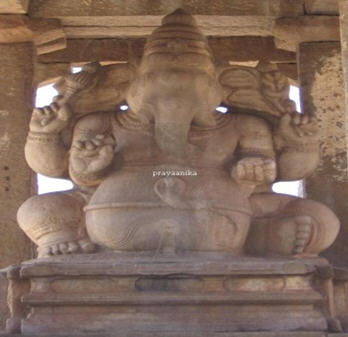
On the slope of Hemakuta Hill, near the Sasivekalu Ganesha is another monolith called in the same vein, the Kadalekalu (gram seed) Ganesha. The huge seated Ganesha, carved in the round out of a massive boulder, is about 4.5 meters high and is housed in a large shrine with a fine open pillared mandapa in front. The temple also forms one of the important vintage points from which a good and picturesque view could be had of the Hampi monuments.
Matanga Hill
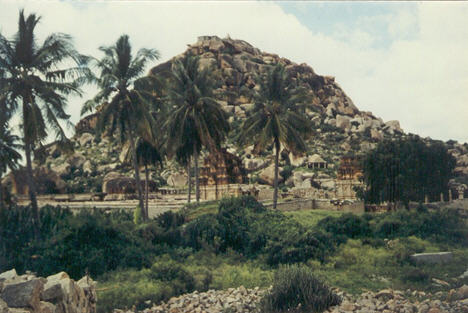
Matanga Hill
The visitor who makes an effort to climb this hill will be rewarded with a breath taking view of the Hampi landscape. One will then appreciate the forethought of Vijayanagara rulers in choosing Hampi as their capital. A beautiful view of the Achyuta Raya Temple can be seen from the top of this hill.
The name to Matanga Hill comes after the Sage Matanga who used to live on this hill in Treta Yuga, the period of Ramayana. It is also the place where Sugriva benefited from the magical protection of the sage Matanga who had placed a curse of death on Vali, if he dared enter the area of Matanga Hill.
Sasivekalu Ganesha Temple

Sasivekalu Ganesha Temple
On the slope of Hemakuta Hill beyond the Krishna Temple, there are two huge stone images of Ganesha. First one is the Sasivekalu Ganesha about 2.4 metres tall and ironically named as Sasivekalu or mustard seed. The potbelly of the god is in the shape of mustard seed and hence the name (Sasivekalu means of mustard seed in the local language). The god is seated in a large open mandapa with plain rough square pillars. The right hands hold the ankusa and broken tusk, while the upper left holds a looped pasa or noose. The lower left hand and the trunk are broken. The belly is tied with a snake. This Ganesha is fashioned out of a single boulder in sitting position.
Prasanna Virupaksha Temple
More popularly known as underground Virupaksha temple, this is situated to the west of the Danaik’s enclosure. A large broken loose slab containing an inscription which records a grant to the temple of Prasanna Virupaksha by King Krishnadeva Raya on the occasion of his coronation.
Malyavanta Raghunathaswamy
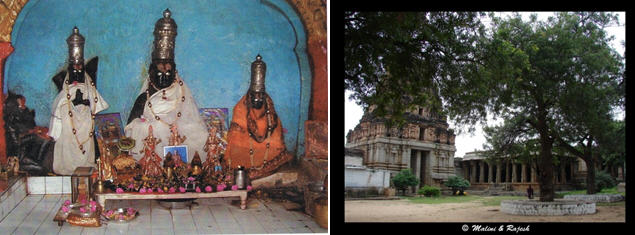
Malyavanta Raghunathaswamy
On the road toward the Kampli, stands the temple of Malyavanta Raghunathaswamy. It is here where Lord Rama and Lakshmana stayed for the rainy season after Sugriva had been installed on the throne. It was also here where Rama and Lakshmana stayed while Hanuman went to search for Sita. The main one of which has a sanctuary with images in black stone Rama and Lakshmana who are in sitting positions, with a standing Sita, and Hanuman kneeling near Them carved from a boulder. The scene is said to depict how Rama and Lakshmana were dismayed and discussing the means to save kidnapped Sita.
Down the hill from here heading west is Madhuvan, which has a little temple of Hanuman. It was here where the monkeys were stopped to enjoy the gardens of fruit after Sita had been found.
Ugra Narasimha
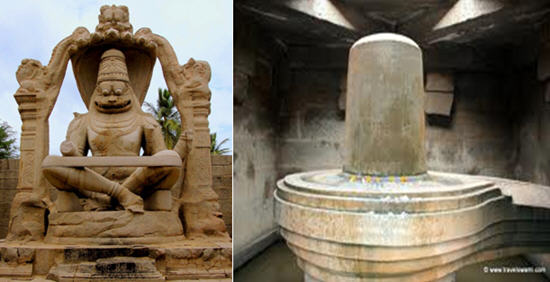
Ugra Narasimha
Nearby is the 6.7m tall monolith of Ugra Narasimha. An inscription nearby states that it was hewn from a single boulder in 1528 during the reign of Krishnadeva Raya. Lakshmi Narasimha : This giant monolithic statue of the man-lion god is the largest icon in Hampi. Narasimha which is one of the ten avatars (incarnation) of lord Vishnu is depicted in a cross-legged seated position. It’s believed that the original image contained his consort Lakshmi sitting on his lap. This image was destroyed during the enemy invasion. Currently only a hand of the goddess resting on his waist can be seen.
Nearby is a shrine with huge three meter high Shiva linga called Badavilinga. It is permanently surrounded by water that comes through an ancient channel.
King’s Balance
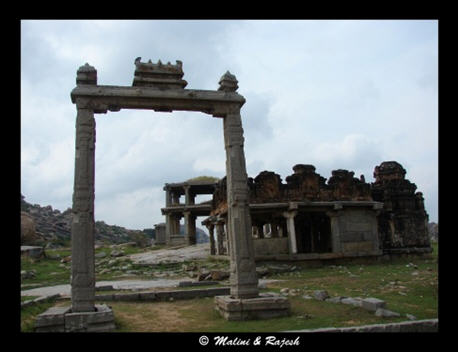
King’s Balance
Hampi is also full of surprises: like the King’s Balance where kings were weighed against grain, gold or money which was then distributed to the poor, the Queen’s Bath, a swimming pool, 50 ft.long and 6 ft.deep, with its arched corridors, projecting balconies and lotus-shaped fountains that once sprouted perfumed water, the two-storeyed
Lotus Mahal:
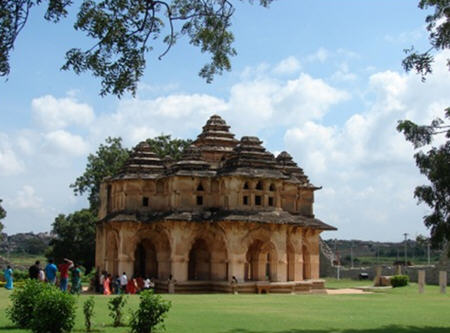
Lotus Mahal
Shaped like a lotus flower from top, this two-story structure has beautiful arc ways set in geometric regularity. It was an air-cooled summer palace of the queen.
Elephant Stables: This huge stable, a beautiful example of Hindu-Muslim style of architecture, housed about 11 elephants in separate compartments.
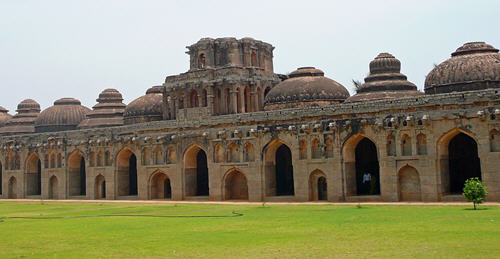
Elephant Stables
Achyuta Raya Temple
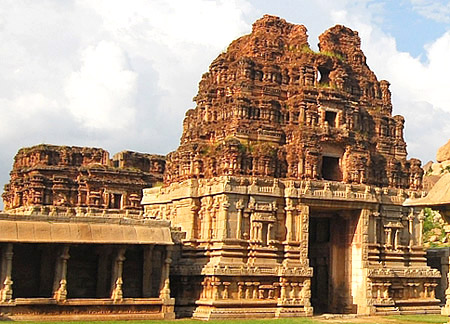
Achyuta Raya Temple
This temple can be reached either from Kodanda Rama Temple through the Bazaar wrongly called “Soolai Bazaar” or “Courtesan Street” or from the Virupaksha Bazaar by climbing the steps next to the monolithic Nandi at the end of the bazaar. Achyutaraya Temple is a large complex built by an officer of the King Achyutaraya, Salakaraju Tirumaladeva. This temple is better known as Achyutaraya temple, in whose period it was built rather than the name of the deity “Tiruvengalanatha” or Lord Venkateshwara.
Hemakuta Hill
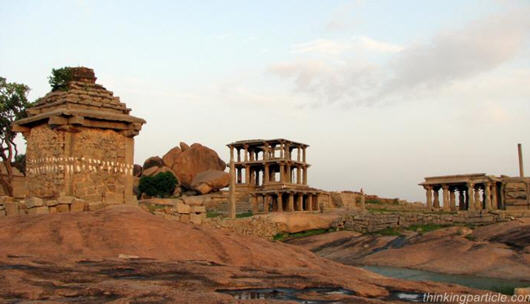
Hemakuta Hill
Hemakuta Hill, south of the Virupaksha temple, contains early ruins, Jain temples and a monolithic sculpture of Lord Narasimha, a form of Lord Vishnu. Hemakuta Hill offers excellent view of Hampi Bazaar.
Lord Shiva did penance on the Hemakuta Hill before he married Parvati. This was also the place where Lord Shiva burnt Kama, the god of lust. This sacred hill lies to the proper right of the Virupaksha Temple.
Kodanda Rama Temple
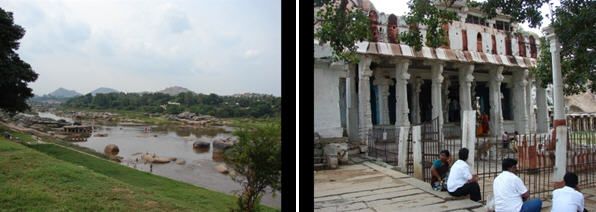
Kodanda Rama Temple
The Kodanda Rama Temple is situated towards the east of Hampi at the end of the Virupaksha Bazaar. A small pathway from Virupaksha Bazaar at the east end leads along the river bank to Kodanda Rama temple. This temple faces Chakrathirtha, the most sacred bathing ghat in the river.
The spot marks the place where Lord Rama crowned Sugriva as the King of Kishkhinda. The rectangular “GarbhaGriha” of the temple contains about 15 feet tall standing figures of Lord Rama, Sita and Lakshmana. These Deities are carved out of a natural boulder.
Just behind the temples of Kodanda Rama are the temples for Sudarshana in the shape of a human figure with sixteen hands and Yantrodharaka Anjaneya or Hanuman.
Pattabhirama Temple
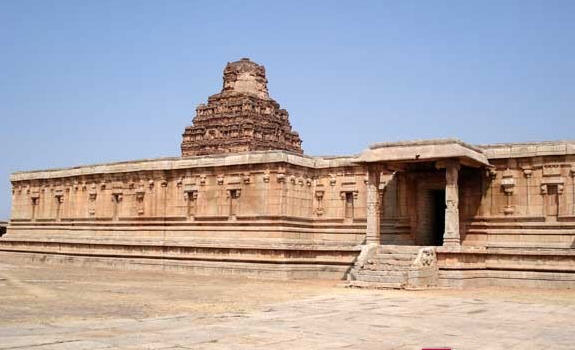
Pattabhirama Temple
The temple is about 0.8 kilometres to the east of Kamalapura. Though it contains two inscriptions of King Achyuta Raya, its date is not clearly determinable.
The east-facing sanctum is a tri-talavimana with an antarala, ardha-mandapa and maha-mandapa. The large and square maha-mandapa is a finely proportioned seven aisled structure with tall and slender composite pillars of various types.
Pampa Sarovar is a lake in Koppal district near Hampi in Karnataka. To the south of the Tungabhadra river, it is considered sacred by Hindus and is one of the five sacred sarovars, or lakes in India. Pampa Sarovar is regarded as the place where Pampa, a form of Shiva’s consort Parvati, performed penance to show her devotion to Shiva. The Pampa Ambika temple next to the kund is small.
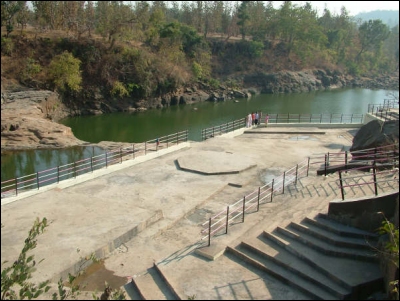
Pampa Sarovar
It is also one of the Sarovar that finds a mention in the Hindu epic, Ramayana, Pampa Sarovar is mentioned as the place where Shabari (also Shabri), a disciple of the Rishi Matanga, directed Rama as he journeyed southwards on his quest to redeem Sita, his wife, from the demon king Ravana. According to the story, Shabari, a pious devotee of Rama, prayed faithfully everyday to see Rama. She lived in the ashram of her guru, Matanga in the place now known as Matanga Parvat, in Hampi. Before her guru Matanga Rishi died he told her she would certainly see Rama. After his death, Shabari continued to live in the ashram awaiting Rama. Many years passed by and Shabari became an old woman, before Rama stopped at the ashram on his journey to Lanka. She proceeded to feed Rama and his brother Lakshmana. Touched by her piety Rama and Lakshmana bowed down at her feet. Then, they narrated to her the incident of Sita’s kidnapping and Shabari suggested that they seek help from Hanuman and Sugriva of the monkey kingdom who lived further south near the Pampa Lake.
Five hundred years ago Lord Caitanya came here too:
(a) Chaitanya Charitamrita Madhya lila 9.311 :
“dhanus-tirthadekhi’ karila nirvindhya tesnaners yamuka-giriaila dandakaranye” – Lord Caitanya next arrived at Dhanus-tirtha, where He took His bath in the river Nirvindhya. He then arrived at Rsyamuka Mountain and then went to Dandakaranya.
Purport: According to some opinions, Rsyamuka is a chain of mountains beginning at the village of Hampi-grama in the district of Belari. The mountain chain begins along the bank of the river Tungabhadra, which gradually reaches the state of Hyderabad;
(b) Chaitanya Charitamrita 9.316:
“prabhuasi’ kailapampa-sarovaresnanapancavatiasi, tahankarilavisrama”-
Eventually Sri Caitanya Mahaprabhu arrived at a lake known as Pampa, where He took His bath. He then went to a place called Pancavati, where He rested.
PURPORT- According to some, the old name of the Tungabhadra river was Pamba. According to others, Vijaya-nagara, the capital of the state, was known as Pampatirtha. According to still others, the lake near Anagundi, in the direction of Hyderabad, is Pampa-sarovara. The river Tungabhadra also flows through there. There are many different opinions about the lake called Pampa-sarovara.
Lord Nityananda’s Traveling to the Holy Places: “Lord Nityananda next took bath in the Gomati, Gandaki, and Sona Rivers. He also climbed the top of Mahendra Mountain. There He offered obeisances to Lord Parasurama. He also visited Haridvara, the source of the Ganges. The Lord took bath in Pampa, Bhimarathi, Venva, and Vipasa Rivers.” and in Vrindavanadasa Thakur’s Sri Chaitanya Bhagavat, Adi Lila Chapter 9: “Thereafter Sri Nityananda went to Gomati and bathed in the waters of Gandaki and Sona. He climbed the Mahendra Hill where He offered obeisances to Lord Parasurama. From there He travelled to Haridvara, the source of Mother Ganga. He visited Pampa, Bhima, Godavari, Benva and in the Bipasa (or Vyasa) river He remained submerged in the water for a while.”
Pampa sarovar is also famous for the pushtimarg vaishnavas, where in Srimad Vallabhacahrya had performed Srimad Bhagavad in the 16th century.
Anjaneya Hill
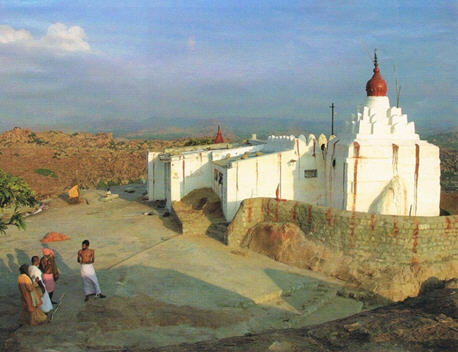
Anjaneya Hill
This hill top Hanuman temple, is believed to be the birthplace of Hanuman and is located in the center of Anegundi area (original Kishkinda). You can see this hill from the Hampi side of the river as you trek along the Kampa Bhups’s (the riverside trek) Path.
At the top of the hill is the temple dedicated for Hanuman. He was born to Anjana. Thus Hanuman is also known as Anjaneya and his birthplace as Anjaneyadri (Anjaneya’s hill). On the way up there is one place called kesaritirtha, the cave where Hanuman’s father Kesari, had lived.
The deity of Hanuman is carved on the rock. Also is the small shrine for Rama and his consort Sita inside the temple.
In Anegudi is the old Raghunatha temple where worship still continues. In sanctum there is small Vishnu deity about three feet long reclining on Seshanaga. In the back of the temple on the right side is a separate shrine to Lakshmi. Not far from the temple is the Samadhi tomb of Madhvacarya’s disciple Narahari Tirtha.
Hampi Yantroddhara Anjaneya Temple
Situated right behind the Kodanda Rama Temple near the Chakrathirtha, Yantroddhara Anjaneya Temple, also known as Yantroddharaka Anjaneya Temple is one of the most sacred places in Hampi. The temple is dedicated to Lord Hanuman. The temple has a very interesting story behind its origin.
Sri Vyasathirtha, a great scholar saint during the reign of King Krishna Deva Raya used to go to very calm spots on the banks of river Tungabhadra and meditate uninterrupted. One day, while he was meditating in a hillock near Chakratirtha, an image of Lord Hanuman kept coming to his mind. This happened only at that particular spot and nowhere else, even in nearby hillocks.
Sri Madhvacharya (believed to be an incarnation of Lord Hanuman) appeared in the dreams of Sri Vyasathirtha and instructed him to install a deity of Lord Anjaneya (Hanuman) next time. The next time Sri Vyasathirtha saw the image in the middle of his meditation, without any delay, he drew the image from his mind on to a rock using an Angara (coal used by Brahmins during Pooja performance). To his surprise, a monkey came to life from the rock and jumped out of the rock and his drawing would disappear. He repeated the process of drawing and every time, a monkey would jump out of the rock and the drawing would disappear. This happened 12 times.
Full of surprise, Sri Vyasathirtha finally decided to bind the image of Lord Hanuman in a Yantra. A small temple was built there and hence the temple has the name Yantroddhara Anjaneya. In the core of the Yantra is the statue of Lord Hanuman in Padmasana position. This is probably the only temple of Lord Hanuman in a sitting position which is generally in a flying or blessing position. The Yantra here is a form of binding which looks like a 6 cornered star. The star is encircled in a circle with flames going outwards giving it the drawing look of a sun. A closed, benzene like ring of 12 monkeys holding each others’ tails can also be found around the star and the sun which forms the outermost structure of the yantra.
It’s the place where, Hanuman first saw Lord Rama and Lakshmana.
Sugriva’s Cave
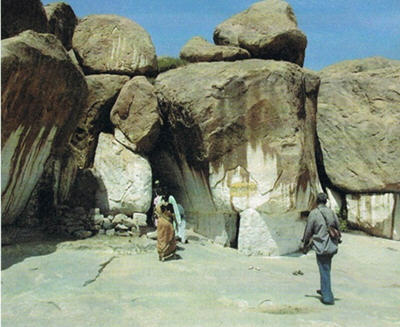
Sugriva’s Cave
Located almost on the river shore, this is a naturally formed cave by huge boulders one leaning over the other.
It’s believed that this is the place where Sugreeva lived. He used the cave to hide the jewels dropped by Sita, when the demon king Ravana abducted her. Later Sugreeva met Rama & Laxmana nearby the riverside searching for Sita. The colored pattern at the rock in locale parlance called Sitakonda. It depicts the pattern on the costume of Sita. Near the cave at the riverside Sugriva met Lord Rama and Lakshmana when they came here in search of goddess Sita.
A number of carved footprints can be seen on the floor of this flat surface. This depicts the footprints of Rama & Lakshmana. Notice them carefully.
